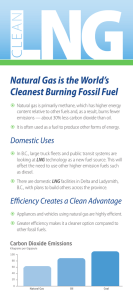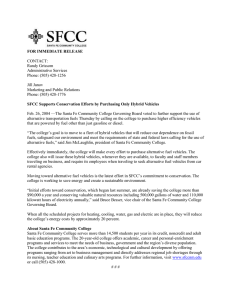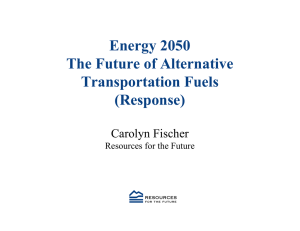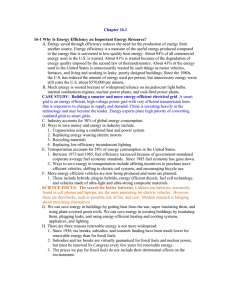Fuels and Propulsion Systems for the Future
advertisement
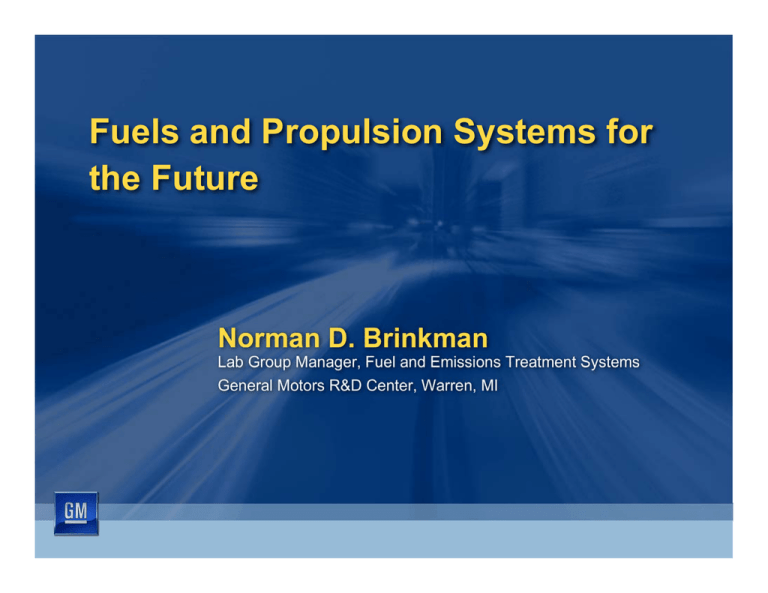
Fuels and Propulsion Systems for the Future Norman D. Brinkman Lab Group Manager, Fuel and Emissions Treatment Systems General Motors R&D Center, Warren, MI GM Sees a Change Coming Drivers for Change World population and global vehicle parc Transportation “Well-to-Wheels” CO2 emissions Energy security Demand for country or region-specific solutions 2 Transportation is a growth industry! World Population Global Vehicle Parc Billions 12% 16% 6 12% 4 10% 2 8% 0 0% 1980 1990 2000 2020 Percent 15% 8 Sources: U.S. Census Bureau International Population Database, GM Global Market & Industry Ana 3 Transportation “Well-to-Wheels CO2 Emissions Source: World Business Council for Sustainable Development Note: Each curve represents the effects of individual technology penetrations to near 100% without regard to feasibility 4 Global Energy Demand – 2030 Global: 2.0%/yr 70% over 2003 MBDOE 100 400 3.7% 106 120 Non-OECD 2003 2030 1.3% 79 80 60 40 0 OECD 300 250 MBDOE 56 0.7% 45 37 195 200 1.8% 37 23 20 350 88 150 39 1.0% 23 18 2.4% 18 9 2.8% 22 2.6% 13 10 6 100 111 NonOECD Asia Middle East Africa Central & South America 146 50 0 OECD OECD Non- OECD North Europe OECD Asia America EuropeEurasia 3.0% 1.0% 2003 2030 Source: DOE-EIA 2006 5 So What’s the Solution? In GM’s view we must Increase fuel efficiency of conventional propulsion vehicles in response to market demands Displace a portion of petroleum fuel usage Diversify energy sources for use in transportation applications Reduce net emissions of carbon dioxide 6 GM Advanced Propulsion Technology Strategy Improved Vehicle Fuel Economy & Emissions Hydrogen Fuel Cell Vehicles Reduced Petroleum Consumption Battery Electric Vehicles Hybrid Electric Vehicles (incl. Plug-In HEV) IC Engine and Transmission Improvements Near-Term Mid-Term Long-Term Petroleum (Conventional and Alternative Sources) Fuel Infrastructure Bio Fuels (Ethanol E85, Bio-diesel) Electricity (Conventional & Alternative Sources) Hydrogen 7 GM Advanced Propulsion Technology Strategy Improved Vehicle Fuel Economy & Emissions Hydrogen Fuel Cell Vehicles Reduced Petroleum Consumption Battery Electric Vehicles Hybrid Electric Vehicles (incl. Plug-In HEV) IC Engine and Transmission Improvements Near-Term Mid-Term Long-Term Petroleum (Conventional and Alternative Sources) Fuel Infrastructure Bio Fuels (Ethanol E85, Bio-diesel) Electricity (Conventional & Alternative Sources) Hydrogen 8 Conventional Propulsion Systems Gasoline Improve fuel efficiency: Active Fuel Management Variable Valve Timing (VVT) Direct Injection Turbocharging Lean Combustion: HCCI / Stratified Diesel Improve Emissions: Low-Temperature Combustion Advanced Air Handling Model-Based & Closed-Loop Control Efficient NOx aftertreatment 9 GM Advanced Propulsion Technology Strategy Improved Vehicle Fuel Economy & Emissions Hydrogen Fuel Cell Vehicles Reduced Petroleum Consumption Battery Electric Vehicles Hybrid Electric Vehicles (incl. Plug-In HEV) IC Engine and Transmission Improvements Near-Term Mid-Term Long-Term Petroleum (Conventional and Alternative Sources) Fuel Infrastructure Bio Fuels (Ethanol E85, Bio-diesel) Electricity (Conventional & Alternative Sources) Hydrogen 10 GM Hybrid Portfolio 2001 2-Mode Hybrid Light Hybrid 2002 2003 2004 2005 2006 2007 2008 2009 2010 GM/Allison Hybrid Bus Chevy Silverado/GMC Sierra Saturn VUE Hybrid Saturn AURA/Chevy Malibu Tahoe/Yukon 2-Mode Hybrid Escalade Silverado/Sierra Saturn VUE 2-Mode Plug-In Saturn VUE (timing not announced) 11 Chevy Volt Concept Electric Drive Motor 120 kW / 320Nm (peak) Li Ion Battery Pack 136 kW peak power 16 kWh energy 53 kW Generator Internal Combustion Engine 1.0L 3-cylinder turbo 12 Advanced Battery Technology Much improvement over time Focused on “power” for hybrids, NOT “energy” for plug-ins and pure electric vehicles Lithium-ion chemistry can provide both power and energy Greatest hurdle: Develop large, high-volume lithium-ion battery packs Individual cells that meet requirements exist Cost ($/kWh) Requires intensive development with battery sources 13 GM Advanced Propulsion Technology Strategy Improved Vehicle Fuel Economy & Emissions Hydrogen Fuel Cell Vehicles Reduced Petroleum Consumption Battery Electric Vehicles Hybrid Electric Vehicles (incl. Plug-In HEV) IC Engine and Transmission Improvements Near-Term Mid-Term Long-Term Petroleum (Conventional and Alternative Sources) Fuel Infrastructure Bio Fuels (Ethanol E85, Bio-diesel) Electricity (Conventional & Alternative Sources) Hydrogen 14 15 GM’s Newest Fuel Cell Stack 4th generation fuel cell stack 372 single fuel cells Power: 73kW continuous 110kW peak Power density: 1.6kW/liter 16 Project Driveway - 100 Vehicle Fleet World’s largest fuel cell vehicle fleet With customers later this year 4th-generation fuel cell propulsion Engineered for 50,000 miles of life Able to start and operate in sub-freezing temperatures. 17 GM Advanced Propulsion Technology Strategy Improved Vehicle Fuel Economy & Emissions Hydrogen Fuel Cell Vehicles Reduced Petroleum Consumption Battery Electric Vehicles Hybrid Electric Vehicles (incl. Plug-In HEV) IC Engine and Transmission Improvements What about Energy Source Diversification? Near-Term Mid-Term Long-Term Petroleum (Conventional and Alternative Sources) Bio Fuels (Ethanol E85, Bio-diesel) Electricity (Conventional & Alternative Sources) Hydrogen 18 Alternate Resources – A Blending Liquid Fuels / Electricity / Hydrogen as the In-Vehicle Energy Carriers Strategy Oil Energy Carrier Petroleum Fuels (Conventional) 1st and 2nd Generation Biofuels Oil Liquid Fuels (Non-Conventional) Conventional ICE: Gasoline / Diesel ICE Hybrid Methanol or Fischer Tropsch Biomass Propulsion System Syngas CO, H2 Plug-In Hybrid ICE Coal Heat Natural Gas Renewables (Solar, Wind, Hydro) Nuclear Electricity Electric Vehicle Shift Reaction Hydrogen Fuel-Cell Electric Electrification Conversion Critical Dependency on Battery Technology Energy Resource 19 Diverse energy sources are used for electricity generation – based on local resources Existing, global infrastructure with clearly-defined standards Efficient transmission system Spare generation capacity exists: US “valley filling” up to 43% of light-duty fleet * Energy from Renewables (17%) High growth (~52%) but just keeping up with overall demand growth Hydropower already maximixed * PNNL Report 2007; 33miles/day commute Electricity Demand Electricity: Energy Diversity Exemplified Global Electricity Generation 2003 Generation capacity already exists Peak US Daily Load Shape Peak Baseload: Coal Baseload: Nuclear, hydro Midnight Noon Midnight Noon Midnight 20 BIOFUELS are part of the solution U.S. Ethanol Production 30 Billion gal./yr. U.S. Government Survey 20 E10 limit 10 RFA Data 0 2000 2005 2010 2015 22 The GM U.S. “FlexFuel Club” 17 models for 2007 MY! GMC Savana GMC Sierra Chevy Impala Chevy Silverado Chevy Monte Carlo GMC Yukon & Yukon XL Chevy Uplander Chevy Avalanche , Suburban & Tahoe 23 Global Renewable Fuels In U.S., GM has 2 million FlexFuel E85-capable vehicles on the road. Building >400,000 more every year. In Brazil, FlexPower is now available in every passenger car model. FlexPower models account for 90% of sales. In Sweden, Saab leads the environment-friendly car segment with 9-5 BioPower, accounting for 85% of Saab 9-5 sales. 24 Biofuels will play a key role Achieving the maximum potential of biofuels will require continued innovation Plants with high yields and low resource inputs Low cost cellulosic conversion technologies Improved systems for resource and fuel logistics Propulsion technologies that maximize “Field-toWheels” fuel efficiency 25 But what about COAL? World Coal Reserves Exajoules Three expected largest automobile markets have much coal, but little oil Source: Businessweek 2006 27 Multiple Options for Coal Energy Carrier Liquid Fuels Propulsion System Conventional ICE: Gasoline / Diesel ICE Hybrid XTL or Methanol Syngas CO, H2 Plug-In Hybrid ICE Coal Heat Electricity Electric Vehicle Shift Reaction Hydrogen Fuel-Cell Electric Electrification Conversion Critical Dependency on Battery Technology Energy Resource 28 How will Coal be Used? Coal to liquids Fischer Tropsch liquids compatible with oil infrastructure Methanol and dimethyl ether lower manufacturing investment China is the place to watch Electricity Much progress still needed in battery cost and performance Hydrogen Storage technology and infrastructure Affordable CO2 sequestration will be the key to large scale use of coal 29 Fuels and Propulsion are a System Oil Energy Carrier Petroleum Fuels (Conventional) 1st and 2nd Generation Biofuels Oil Liquid Fuels (Non-Conventional) Propulsion System Conventional ICE: Gasoline / Diesel ICE Hybrid XTL or Methanol Biomass Syngas CO, H2 Plug-In Hybrid ICE Coal Heat Natural Gas Renewables (Solar, Wind, Hydro) Nuclear Electricity Electric Vehicle Shift Reaction Hydrogen Fuel-Cell Electric Electrification Conversion Critical Dependency on Battery Technology Energy Resource 30 Characteristics of best fuels/propulsion system On a well to wheels basis, maximizes the distance driven per Unit resource (barrel, ton, or acre) Ton of CO2 or other emissions Dollar Minimizes negative impacts on society Flexible to permit regions to use resources they have available 31 Key Research Required Low cost battery technology Low cost, high density hydrogen storage Cost effective logistics and distribution systems for alternative fuels Low CO2 biofuels, such as cellulosic ethanol Affordable CO2 sequestration, especially for coalderived fuels 32 Summary General Motors is Committed to Implement Advanced Propulsion Technologies to optimize fuel efficiency and minimize emissions Accelerate the utilization of biomass with E85 and Bio Diesel capable propulsion systems Drive the electrification of the vehicle Reinvent the automobile with a viable automotive fuel cell system Work closely with all stakeholders make sure we have the best fuels/propulsion system 33
